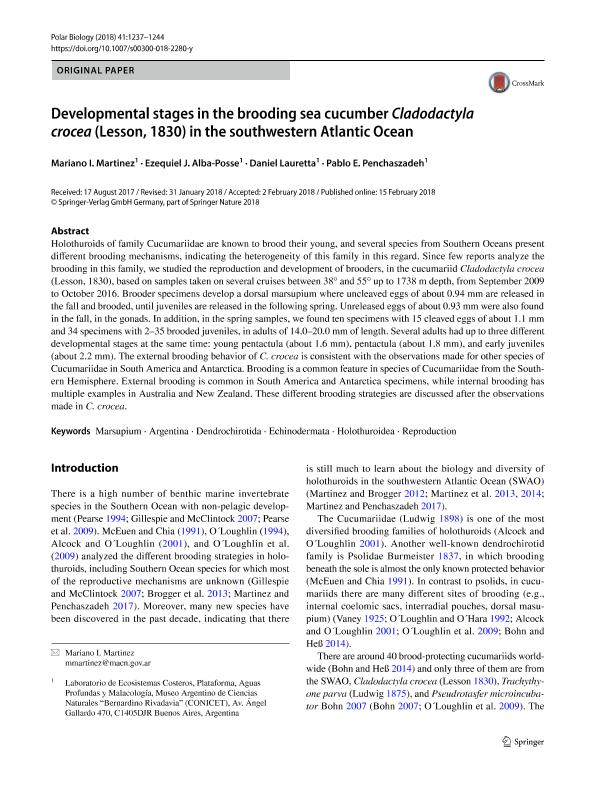Artículo
Developmental stages in the brooding sea cucumber Cladodactyla crocea (Lesson, 1830) in the southwestern Atlantic Ocean
Martinez, Mariano Ignacio ; Alba Posse, Jorge Ezequiel; Lauretta, Daniel Marcelo
; Alba Posse, Jorge Ezequiel; Lauretta, Daniel Marcelo ; Penchaszadeh, Pablo Enrique
; Penchaszadeh, Pablo Enrique
 ; Alba Posse, Jorge Ezequiel; Lauretta, Daniel Marcelo
; Alba Posse, Jorge Ezequiel; Lauretta, Daniel Marcelo ; Penchaszadeh, Pablo Enrique
; Penchaszadeh, Pablo Enrique
Fecha de publicación:
06/2018
Editorial:
Springer
Revista:
Polar Biology
ISSN:
0722-4060
Idioma:
Inglés
Tipo de recurso:
Artículo publicado
Resumen
Holothuroids of family Cucumariidae are known to brood their young, and several species from Southern Oceans present different brooding mechanisms, indicating the heterogeneity of this family in this regard. Since few reports analyze the brooding in this family, we studied the reproduction and development of brooders, in the cucumariid Cladodactyla crocea (Lesson, 1830), based on samples taken on several cruises between 38° and 55° up to 1738 m depth, from September 2009 to October 2016. Brooder specimens develop a dorsal marsupium where uncleaved eggs of about 0.94 mm are released in the fall and brooded, until juveniles are released in the following spring. Unreleased eggs of about 0.93 mm were also found in the fall, in the gonads. In addition, in the spring samples, we found ten specimens with 15 cleaved eggs of about 1.1 mm and 34 specimens with 2–35 brooded juveniles, in adults of 14.0–20.0 mm of length. Several adults had up to three different developmental stages at the same time: young pentactula (about 1.6 mm), pentactula (about 1.8 mm), and early juveniles (about 2.2 mm). The external brooding behavior of C. crocea is consistent with the observations made for other species of Cucumariidae in South America and Antarctica. Brooding is a common feature in species of Cucumariidae from the Southern Hemisphere. External brooding is common in South America and Antarctica specimens, while internal brooding has multiple examples in Australia and New Zealand. These different brooding strategies are discussed after the observations made in C. crocea.
Archivos asociados
Licencia
Identificadores
Colecciones
Articulos(MACNBR)
Articulos de MUSEO ARG.DE CS.NAT "BERNARDINO RIVADAVIA"
Articulos de MUSEO ARG.DE CS.NAT "BERNARDINO RIVADAVIA"
Citación
Martinez, Mariano Ignacio; Alba Posse, Jorge Ezequiel; Lauretta, Daniel Marcelo; Penchaszadeh, Pablo Enrique; Developmental stages in the brooding sea cucumber Cladodactyla crocea (Lesson, 1830) in the southwestern Atlantic Ocean; Springer; Polar Biology; 41; 6; 6-2018; 1237-1244
Compartir
Altmétricas



